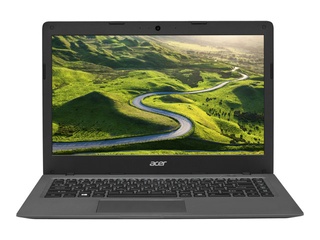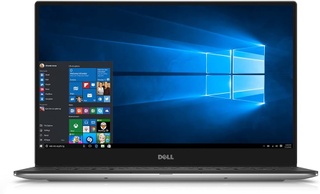Acer Aspire One Cloudbook 14 AO1-431 14" Intel Celeron N3050 vs Dell XPS 13 9350 13.3" Intel Core i5 6200U
Welcome! Today, we're breaking down the differences between the Acer Aspire One Cloudbook 14 AO1-431 and the Dell XPS 13 9350 - no tech jargon, just simple language. We'll compare them on essential factors like performance, design, and user experience. So sit tight whether you're a student seeking a sturdy class companion, a professional hunting for a work-efficient device, or just someone who needs a lifestyle-friendly laptop. We're about to objectively analyze each laptop's high and low points to help you choose wisely. Ready? Let's get started!
System and application performance
Performance in popular 3D games
Viewing angle, color accuracy...
Ports, webcam and other interfaces
Potential battery life
Materials, durability and portability
Design Comparison
Size Comparison
User experience relies heavily on the design elements of a laptop. We'll explore and compare the Acer Aspire One Cloudbook 14 AO1-431 and Dell XPS 13 9350, with emphasis on features such as ergonomics, materials, build quality, portability, and unique design aspects.
Acer Aspire One Cloudbook 14 AO1-431
The Acer Aspire One Cloudbook is your perfect travel companion. Weighing just around 3.5 pounds, it's almost featherlight, and with its slim 0.7-inch profile, it can effortlessly fit into your bag. No more shoulder strains from lugging around hefty laptops! Its heart is a generously sized 14-inch screen, providing you with enough space for marathon study sessions or big work presentations.
The Cloudbook, aptly named for its cloud-hued blue lid, is not only a treat for the eyes, but also a handy tool for students and professionals alike. Its HDMI port feature simplifies connecting to external displays - perfect for showcasing your work at school or during professional presentations.
Get ready to breeze through emails or essays with the user-friendly keyboard layout. Plus, the added bonus of stereo speakers and a handy spot for your 3.5mm audio jack takes your multimedia experiences to new heights.
Dell XPS 13 9350
Conversely, the Dell XPS 13 presents a remarkable mix of fashion and practicality. This model is more compact than its Acer counterpart due to its smaller size (12 inches wide and 7.9 inches high) and slimmer shape (0.3 inches). It's also a bit lighter at just under 2.9 pounds, enhancing its portability even further.
Dell XPS wows you at first sight with its stunning aluminum body that combines strength and style. The bonus? Its backlit keyboard! Not just a pretty feature, it also makes working in dimly lit spaces a breeze - ideal for those burning the midnight oil.
The Dell XPS 13 may have a more compact, 13.3-inch screen, yet it makes up for this with the addition of an interactive touch screen. This laptop also features Thunderbolt ports which allow for rapid data transfer and an external memory slot that provides the option to expand storage as required.
Comparison
Both laptops prioritize easy carry, but the Dell XPS 13 gains an advantage with its extremely light design and small size. The high-quality materials and construction of this model also make it more durable and visually appealing than the Acer Cloudbook. On the other hand, the bigger screen size of the Acer Cloudbook might provide a more relaxed viewing experience for certain users.
Dell and Acer have distinct features tailored to your needs. The Dell laptop boosts your convenience with its backlit keyboard and touchscreen, perfect for an effortless user experience. On the other hand, Acer might not have these, but it offers an HDMI output. This is a handy feature if you often find yourself needing to connect to larger displays.
In summary, both laptops serve their target users effectively. The Acer Aspire One Cloudbook is a perfect match for students or occasional users who require a portable laptop with essential functions that doesn't break the bank. Conversely, professionals or those in search of superior construction and advanced capabilities may find the marginally pricier Dell XPS 13 more worthwhile.
Screen Comparison
| Acer Aspire One Cloudbook 14 AO1-431 14" Intel Celeron N3050 | Dell XPS 13 9350 13.3" Intel Core i5 6200U | |
|---|---|---|
| Resolution | HD | Full HD |
| Screen Size | 14" | 13.3" |
Comparing the Acer Aspire One Cloudbook 14 and the Dell XPS 13 9350, we'll focus on how their screen features impact your daily activities, from gaming to professional graphic design. By simplifying tech jargon and highlighting key similarities and differences, this guide will help you make an informed laptop choice.
Acer Aspire One Cloudbook 14 Screen Features
The Acer Aspire One Cloudbook 14 showcases a balanced screen size of 14 inches. This size strikes a perfect balance, being neither too small to cause eye strain nor too vast to affect portability. However, its resolution measures at 1366 x 768 pixels. While this suffices for fundamental tasks like surfing the internet or editing documents, it might not meet the requirements for more visually demanding activities such as gaming or design work. The pixel density of this screen is around 111 PPI (Pixels Per Inch), which may not provide the most crisp images.
This laptop's screen guarantees you a bright, vivid viewing experience thanks to the LED-backlit LCD panel. Plus, its anti-glare coating makes sure you won't have to squint your eyes in brightly lit settings.
Dell XPS 13 9350 Screen Features
While the Dell XPS 13 9350 may have a more compact 13.3-inch screen, it delivers a full HD resolution of 1920 x 1080 pixels. This means you get incredibly sharp and high-quality visuals - great news if you love gaming or work in graphic design!
With a remarkable pixel density of 165 PPI, this laptop offers you sharper text and more detailed visuals. This makes it an ideal choice for precision-heavy tasks like photo editing or graphic design work.
Comparing it with the Acer model, this laptop shines with an advanced screen technology called IPS (In-Plane Switching). Without getting too technical, IPS simply means your screen displays more accurate colors and is easier to see from different angles - perfect for when you're showing something on your screen to others. Moreover, the Dell XPS 13 9350 has a special feature - a touchscreen! If you like getting hands-on with your tasks, you'll love this bonus convenience.
The Bottom Line
In the world of laptop displays, the Dell XPS 13 9350 stands tall against the Acer Aspire One Cloudbook 14. Its crisp resolution, pixel-packed screen, and responsive touchscreen offer a fantastic visual journey – a big win for gaming enthusiasts and graphic design pros. But don't count out Acer's Aspire One Cloudbook 14 just yet! If you're not too hung up on techy features but appreciate a bigger display or need a screen that's easy on the eyes even in bright light, this model might just tick your boxes.
Hardware Comparison
| Acer Aspire One Cloudbook 14 AO1-431 14" Intel Celeron N3050 | Dell XPS 13 9350 13.3" Intel Core i5 6200U | |
|---|---|---|
| CPU | Intel Celeron N3050 | Intel Core i5 |
| RAM | 2GB | 8GB |
| Storage Size | 64GB | 256GB |
Selecting a laptop involves careful consideration of the hardware components, given their substantial impact on performance across various tasks. Today, we turn our focus to two specific models: the Acer Aspire One Cloudbook 14 AO1-431 and the Dell XPS 13 9350.
CPU Comparison
The Acer Cloudbook highlights an Intel Celeron N3050 processor operating at a base speed of 1.6GHz. This CPU efficiently handles straightforward computing activities such as web browsing or editing documents. Nonetheless, for more intensive tasks like video editing or running high-demand software, this CPU might encounter difficulties.
Alternatively, the Dell XPS 13 is fitted with a stronger Intel Core i5 6200U processor that runs at a speed of 2.3GHz. This CPU can manage multiple tasks and demanding applications effortlessly, making this laptop ideal for professionals and creatives who need a high level of processing power.
RAM Comparison
The Cloudbook comes with 2GB RAM, perfect for light tasks. However, if you often juggle multiple tabs or apps at once, this might feel a bit restrictive.
Unlike other models, the Dell XPS boasts a substantial 8GB of RAM. This extra memory allows you to multitask with ease, keeping multiple applications open and handling demanding tasks without a hitch. It ensures your system stays fast and efficient, no matter how heavy the workload.
Storage Comparison
For storage, the Acer Cloudbook offers 64GB of flash storage. While this may seem small compared to traditional hard drives, flash storage offers faster data access times and less power consumption.
The Dell XPS steps up on storage capacity significantly with its 256GB of flash storage. This larger capacity allows for storing more files locally and can accommodate larger software installations with ease.
Practical Application Impact
For those who require a computer for simple tasks such as sending emails, surfing the internet or typing documents, the Acer Aspire One Cloudbook could be a good fit. With a competent CPU and RAM, it can handle these activities comfortably. Plus, its flash storage ensures fast loading times for applications.
Though the Dell XPS 13 might be more appropriate if you're engaged in multimedia activities such as editing photos or videos, or if you frequently use heavy software. Its superior CPU, larger memory, and expanded storage capacity allows it to manage these tough tasks efficiently without sacrificing speed or performance.
In summing up, each laptop caters to specific user needs. Think about what you'll be using your laptop for - the Acer Cloudbook is a wallet-friendly choice for everyday tasks, while the Dell XPS shines as a robust option for those who require more computing power.
Verdict
Why Acer Aspire One Cloudbook 14 AO1-431 14" Intel Celeron N3050?
- More budget-friendly option with essential features.
- Larger screen size for comfortable viewing during long study or work sessions.
- Lightweight and portable design, ideal for students or users on the go.
Why ?
- Superior performance with Intel Core i5 processor.
- Enhanced user experience with backlit keyboard and touchscreen features.
- Larger RAM capacity for smooth multitasking.
- Crisp Full HD resolution display for better visuals.
Similar comparisons
- Acer Aspire One 10 S1002 10.1" Intel Atom Z3735F vs Acer Switch One 10 (SW1-011) 10" Intel Atom x5-Z8300
- Acer Aspire E5-575G 15.6" Intel Core i5 6200U vs Microsoft Surface Laptop 2 13.5" Intel Core-i7 8650U
- Acer Aspire E15 Touch 15.6" Intel Core i3-4030U vs Dell Inspiron 15 3552 15.6" Intel Core i3 5005U
- Acer Aspire E5-574G 15 15.6" Intel Core i5 6200U vs Microsoft Surface Laptop 13.5" Intel Core i5-7200U
- Acer Aspire E5-573G 15.6" Intel Core i7-5500U vs Framework Professional 13.5" Intel Core i7-1185G7

